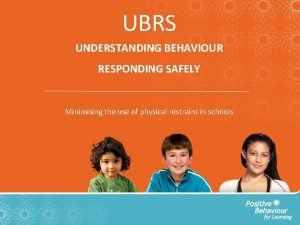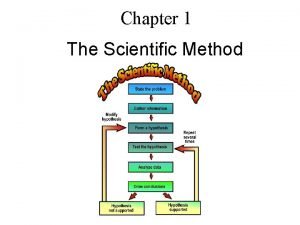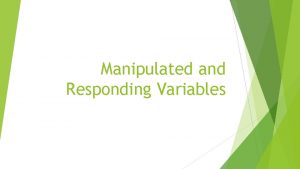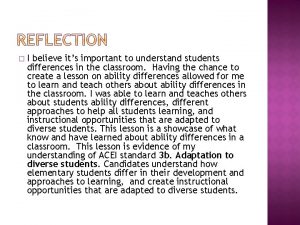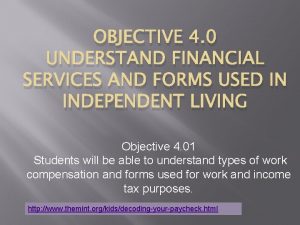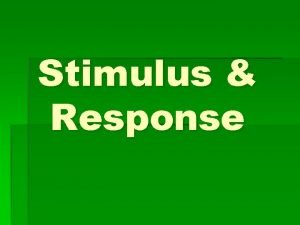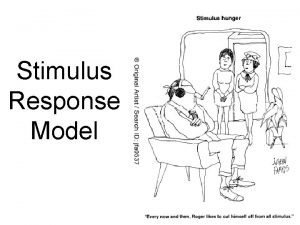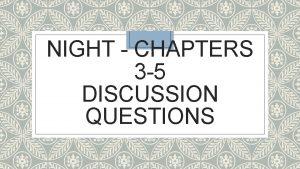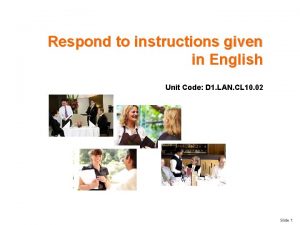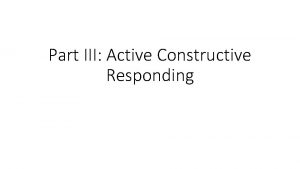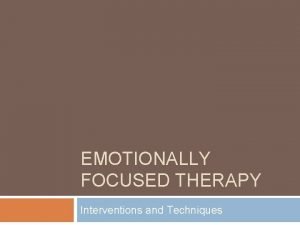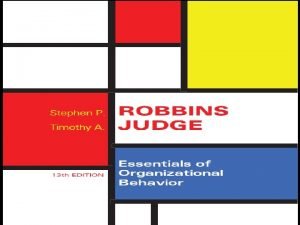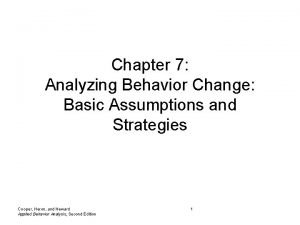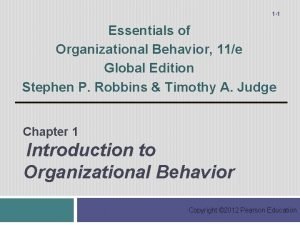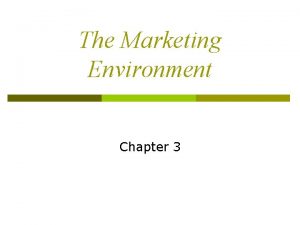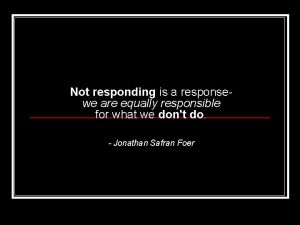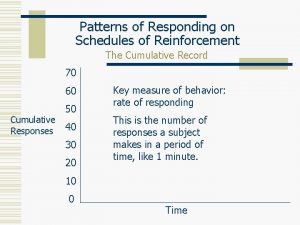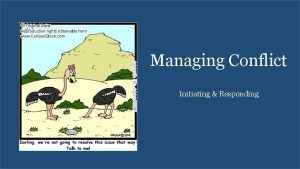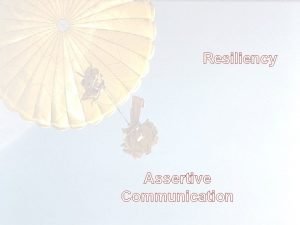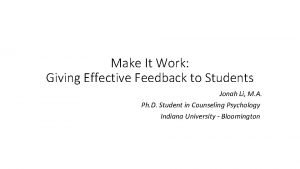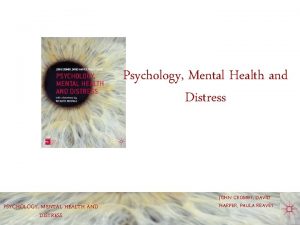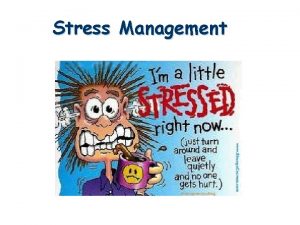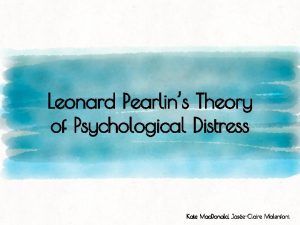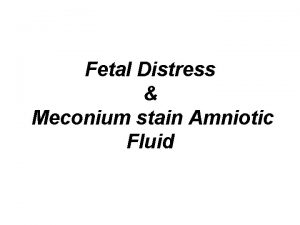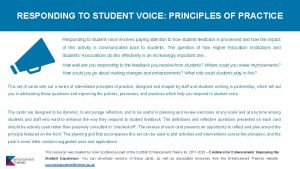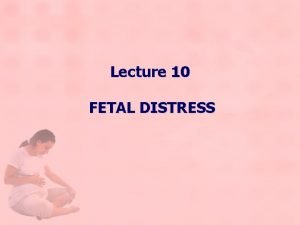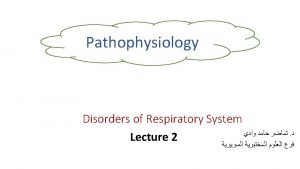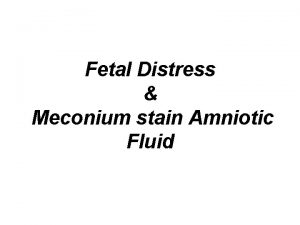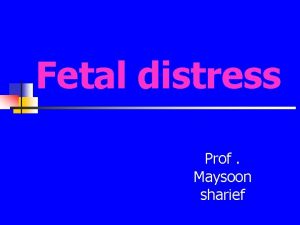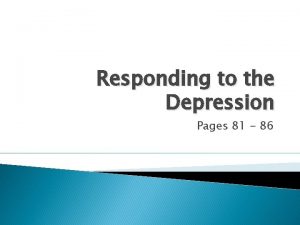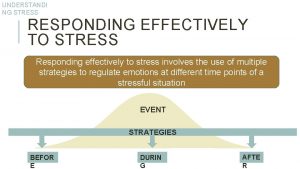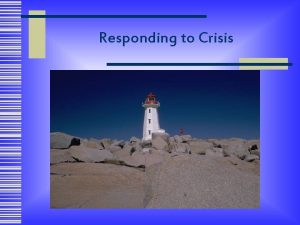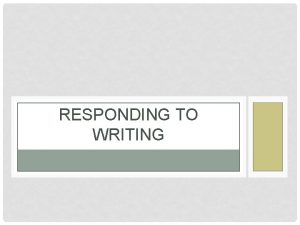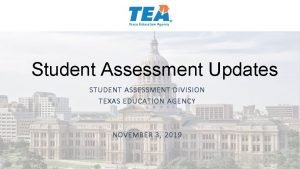Distress Assessment Understanding and Responding to Student Distress





















































- Slides: 53

Distress Assessment: Understanding and Responding to Student Distress in Schools. The Adolescent & Child Urgent Threat Evaluation R. Copeland © e. Med Colorado, Inc. (2000 -2014) J. Schneller © PAR (2005) The Suicidal Ideation Questionnaire W. Reynolds © PAR (1987) Presented to the Washington Association of School Psychologists August 17, 2018 Jay Schneller, Ph. D, NCSP Tacoma Public Schools

Ethics and Confidentiality NASP : …It is ethically permissible to provide psychological assistance without parent notice or consent in emergency situations of if there is a reason to believe a student may pose da danger to other, is at risk for self-harm; or is danger of injury, exploitation, or maltreatment. …Maintain privacy & confidentiality except in those situations in which failure to release information would result in danger to the student or others, or where otherwise required by law. ASCA: … Keep information confidential unless legal requirements demand that confidential information be revealed or a breach is required to prevent serious and foreseeable danger to the student.


Washington Youth Suicide facts: Statistics • An average of 2 youth (ages 10 and 24) die by suicide each week in WA • 15% of WA 6 th graders, 17% of 8 th graders, 19% of 10 graders, and 17% of seniors reported seriously considering suicide in the last year. • Suicide is the second leading cause of death for Washington youth. • Most youth who attempt suicide survive • Males are more likely to complete a suicide attempt & females are more likely to be hospitalized. • Nonfatal self-inflicted injuries by type • Poison (70%), Cut/Pierce (15%), Other (5%), Suffocation (2%), Firearm (1%) • Fatal self-inflicted injuries by type • YSPP. ORG (2008 -2012 - n=4354 – approximate %). (2008 -2012 - n=617 –approximate %). Firearm (40%), Suffocation (40%), Poison (10%), Jump/Fall (5%)

School Shooting Statistics: Odds are one in 1 million that a student will die at school as a result of a violent act. Statistics • 95% were current students. • 93% had behavior that caused others concern prior to attack. • 93% planned out the attack in advance. • 68% acquired the weapon used from home or from a relative. • 63% had a known history of weapons use. • 59% occurred during the school day. • 37% exhibited interest in violence in writings, poems, essays, or journals. • 27% exhibited interest in violent movies. Motives • 75% felt bullied/persecuted/threatened by others. • 61% motivated by desire for revenge. • 34% motivated by attempt to solve a problem. • 27% motivated by suicide or desperation. • 24% motivated by desire for attention or recognition. • 54% had multiple motives. http: //info. publicintelligence. net/FBI_The_School_Shooter_A_Quick_Reference_Guide. pdf

www. schoolpsych. net

www. schoolpsych. net

Empirically Based Models for Effective Crisis Mitigation in the Schools: “A clear, consistent, rational, and well-structured system for dealing with threats is vitally important in a school. ” -FBI

Distress Assessment Process based on the threat assessment approach of the National Center for the Analysis of Violent crime model Consider approaching the process in a linear manner as outlined here. • Step 1: Receipt of the Communication • • • Admin becomes aware of a student in distress Admin initiates EBDF Process (admin interview) Complete EBDF Demographic info & Summary of Concern • Step 2: Assessment of the communication • Note specificity of the communication regarding plan, motive, etc. • Step 3: Assessment of psychosocial factors • • Parent interview (ACUTE) followed by student interview (PETRA) Consider other sources of info including mandatory teacher input Consider SIQ or other measure to quantify suicide risk, if concern Estimate Violence & Suicide Risk based on available information • Step 4: Documentation & Response • • • Team meeting, share/update results, Document concerns regarding student safety & other factors as noted Consider protective factors as well as risk factors Determine & implement response Schedule follow-up Copeland, R. (2005). Adolescent and child urgent threat evaluation. Psychological Assessment Resources, LLC, Lutz, FL O’Toole, M. (2000). The school shooter: A threat assessment perspective. Washington, DC: FBI Schneller, J. (2005). Psychosocial Evaluation and Threat Risk Assessment. Psychological Assessment Resources, Inc. Lutz. FL

Emotional or Behavioral Distress Form Demographic Information Gathering information Interview those involved Summarize the Concern Identify the details of the incident Characteristics of the Threat target, means, specificity, preparation, etc. Estimate violence risk as high, medium, or low Social, Emotional & Behavioral factors in need of intervention Estimate Suicide Risk Low, Medium, or High Identify Alcohol & Drug use concerns Low, Medium, or High Document Recommendations Immediate & follow-up strategies to prevent violent act Notes / elaboration of findings assign case manager schedule follow up date This form is available online Follow-up & monitoring

Emotional or Behavioral Distress Form Demographic Information Gathering information Interview those involved Summarize the Concern Identify the details of the incident Characteristics of the Threat target, means, specificity, preparation, etc. Estimate violence risk as high, medium, or low Social, Emotional & Behavioral factors in need of intervention Estimate Suicide Risk Low, Medium, or High Identify Alcohol & Drug use concerns Low, Medium, or High Document Recommendations Immediate & follow-up strategies to prevent violent act Notes / elaboration of findings assign case manager schedule follow up date This form is available online Follow-up & monitoring

“They just snapped. ” • There are many warning signs • Change in behavior, grades, social interaction • Practice behaviors • Threats • In fact, targeted violence represents a pattern of thinking and behavior that is understandable and often discernable; likely preceded by a communication of intent. National School Safety Center. (2001). Report on school associated violent deaths. CA. Vossekuil, B. , Reddy, M. , Fein, R. , Borum, R. , & Modzeleski, W. (2000). U. S. Safe school initiative: An interim report on the prevention of targeted violence in schools. Washington, DC: U. S. Secret Service, National Threat Assessment Center.

Key Terms • Threat: Any expression of intent to do harm. • Direct Threat: Straightforward, clear, explicit. “I am going to place a bomb in the school’s gym. ” • Indirect Threat: Vague, unclear, ambiguous. “If I wanted to, I could kill everyone in this school. ” • Veiled Threat: Strong implication but not explicit. “We would be better off without you around anymore. ” • Conditional Threat: Typically seen in extortion cases. “If you don’t pay me, I will place a bomb in the school. ” O’Toole, M. (2000). The school shooter: A threat assessment perspective. Washington, DC: FBI

Key Terms Continued • Threat Risk Assessment: A method of identifying, assessing, and managing persons who pose a risk for violence. • Profiling: The arbitrary identification of individuals who may pose a threat. • Predisposing factors: Characteristics that increase the likelihood of a threat being carried through. • Precipitating factors: suggests degree of progress toward a violent act. • Motive: Underlying purpose for the threatening behavior. O’Toole, M. (2000). The school shooter: A threat assessment perspective. Washington, DC: FBI

Characterizing Threats of Violence q. Low q. The threat is vague and/or indirect. q. The details of the threat are inconsistent, implausible, and/or lacking detail. q. The threat lacks realism. q. Medium q. High q. The threat is more direct and more concrete than a low level of threat. q. The threat is direct, specific, and plausible. q. There is indication of possible place and time. q. There is evidence that steps have been taken to carry out the threat. q. There is indication of preparatory steps to carry out the threat. • Lingering concern • Identification of the victim • Reason for the threat • Means, weapon, or method • Date, time, or place “The degree of detail may reflect the level of risk associated with the threat being carried out. ” - FBI O’Toole, M. (2000). The school shooter: A threat assessment perspective. Washington, DC: FBI

Threat Risk Indicators • Expression of lethally violent or suicidal behaviors. • Identification of a particular victim other than self. • Violent or suicidal behavior involving a note. • Access to firearms or other lethal weapons. • Evidence of an executable and likely lethal plan. • Expressions of dire predictions (e. g. , “being dead” or “stopping the pain”). • Behavior reflecting “black & white” thinking words like only, forever). (e. g. , • Expressions of fantasies of death (e. g. , “eternal sleep” or “reunion with family”). Copeland, R (2005). Adolescent and child urgent threat evaluation. Psychological Assessment Resources, LLC, Lutz, FL. ACUTE

Predisposing Characteristics that influence carrying out a threat of violence • History of arrests before age 15, aggression, verbal cruelty, violence, or antisocial behavior • History of suicidal behavior with self-inflicted tissue injury* • History of sexual delinquency or sadism • History of self-mutilation • Soft neurological signs, coordination or language difficulties, or sub-average IQ* • Diagnosis of ADHD or Conduct Disorder* • Diagnosis of Paranoid Personality Disorder* *Related to Impulsivity Copeland, R (2005). Adolescent and child urgent threat evaluation. Psychological Assessment Resources, LLC, Lutz, FL. ACUTE

Predisposing Characteristics Continued • Family history of mental illness or suicide • Family history of violence or substance abuse • Unstable home environment* • Escalation of rage outbursts if present* • Pattern of poor social relationships, few family ties, personal losses of peers, or problems in school* • Acquisition of behavior and skills of a delinquent peer group • Likelihood to support follow-up plan *Related to Impulsivity Copeland, R (2005). Adolescent and child urgent threat evaluation. Psychological Assessment Resources, LLC, Lutz, FL. ACUTE

Early Precipitating Characteristics signifying potential progress & increased risk of carrying out a threat of violence • Expressions with certain death as the objective • Identification of a particular victim(s) • Expressions of dire predictions • Violent or suicidal behavior involving a note • Access to firearms or other lethal weapons • Alcohol or drug abuse • Perception of actual or perceived social tension • Result of threat to self-esteem and/or humiliation • Expected return to problematic situation or setting Copeland, R (2005). Adolescent and child urgent threat evaluation. Psychological Assessment Resources, LLC, Lutz, FL. ACUTE

Late Precipitating Characteristics indicate an impending act of violence following a threat • Black & white thinking (e. g. , words like only, forever) • Well developed (i. e. , plausible) and lethal plan • Fantasies of death, such as “eternal sleep” or “reunion with family” • Symptoms of agitation or motor restlessness Copeland, R (2005). Adolescent and child urgent threat evaluation. Psychological Assessment Resources, LLC, Lutz, FL. ACUTE

Precipitating Factors Related to Impulsivity that increase the risk following a threat of violence • Presentation of agitation or motor restlessness • Alcohol or drug abuse • Actual or perceived social tensions • Result of threat to self-esteem and/or humiliation Copeland, R (2005). Adolescent and child urgent threat evaluation. Psychological Assessment Resources, LLC, Lutz, FL. ACUTE

Adolescent & Child Urgent Treat Evaluation R. Copeland, MD & D. Ashley © PAR (2005) • Format: 27 -item structured to identify risk for near-future violence (e. g. , hours to days). • Standardization: 542 children and adolescents ages 8 -18 years in four study groups: (a) Non-Threat, (b) Suicide Threat, (c) Homicide Threat, and (d) Homicide-Suicide Threat • Internal consistency: moderate to high for cluster scores, Total score alpha coefficients ranging from. 70 -. 85. • Inter-rater reliability: clusters ranging from. 74 -. 99; Total score. 94 • Test-retest: . 71 -. 97 over a period of 24 to 48 hours. • Convergent and discriminant validity: demonstrated via Clinical Assessment of Depression™ (CAD™), the Children's Depression Inventory (CDI), and the Suicide Ideation Questionnaire (SIQ). • Criterion-related validity: demonstrated in age-matched psychiatric group (n = 70) who were not at risk for violence. • Professional Requirements: school psychologist, guidance counselor, clinical social worker. • Test materials: (20 minutes) Rating form, Professional manual. Copeland, R (2005). Adolescent and child urgent threat evaluation. Psychological Assessment Resources, LLC, Lutz, FL. ACUTE

ACUTE Domains Adolescent & Child Urgent Threat Evaluation Interpretation: Threat cluster classification Precipitating characteristics Predisposing characteristics Impulsivity indicators Total ACUTE Raw Score Quantitative interpretation Extreme Clinical risk High Clinical risk Moderate clinical risk Low clinical risk Percentile range >95% 75 -94 34 -74 <33%


FBI Threat Assessment Methodology: A four-pronged approach • Prong one: Personality Traits & Behavior • Prong two: Family Dynamics • Prong three: School Dynamics • Prong four: Social dynamics ”This model provides a framework for evaluating a student to determine if they have the motivation, intention, ability, & means to carry out a proclaimed threat. ”- FBI O’Toole, M. (2000). The school shooter: A threat assessment perspective. Washington, DC: Federal Bureau of Investigation

FBI Four-Pronged Assessment Approach: Prong one: Personality Traits & Behavior • • • • • Inappropriate, macabre, insulting, belittling, or mean humor Exaggerated sense of entitlement & need for attention Behavior appears relevant to carrying out a threat Fascination or interest in sensational violence Rationalization of violent ideology & behavior Lack of empathy, dehumanization of others “Injustice collector” - externalizes blame Intolerance, hatred, and/or prejudice Anger management problems Low tolerance for frustration • Manipulation of others Failed love relationship • Changes in behavior Rigid and opinionated • Closed social group Attitude of superiority • Signs of depression Negative role models Poor coping skills • Narcissism Lack of resiliency • Alienation Lack of trust • Leakage O’Toole, M. (2000). The school shooter: A threat assessment perspective. Washington, DC: Federal Bureau of Investigation

FBI Four-Pronged Assessment Approach: Prong two: Family Dynamics • No limits or monitoring of TV and internet • Turbulent parent-child relationships • Acceptance of pathological behavior • Student “rules the roost” • Access to weapons • Lack of intimacy O’Toole, M. (2000). The school shooter: A threat assessment perspective. Washington, DC: Federal Bureau of Investigation

FBI Four-Pronged Assessment Approach: Prong three: School Dynamics • Student’s attachment & involvement in school • Inflexible culture & impersonal environment • Tolerance for disrespectful behavior • Pecking order among students • Perception of inequitable discipline • Racial or class divisions • Poor trust between staff and students • Unsupervised computer access • Code of silence • Culture of bullying, victimization, & bystanders “It is important to understand, from the student’s perspective, why he would target his own school. ” - FBI O’Toole, M. (2000). The school shooter: A threat assessment perspective. Washington, DC: Federal Bureau of Investigation

FBI Four-Pronged Assessment Approach: Prong four: Social Dynamics • Unmonitored access to media & entertainment • The Copycat Effect after violence in the news • Outside interests can mitigate school violence • Use or change in use of drugs or alcohol • Peer groups of similarly-minded students O’Toole, M. (2000). The school shooter: A threat assessment perspective. Washington, DC: Federal Bureau of Investigation

PETRA A Psychosocial Organization of the Four-Pronged Model Psychological Domain • • Ecological Domain • Home • School Alienation Depression Aggression Egocentrism Resilience Domain • Coping • Stress “How does a student come to of feeling that shooting others at school was in some way an answer to his problems? Were there signs along the way –not a catalogue of traits identifying him as a predicted killer, but clues that could have indicated a need for help? ” -FBI

Alienation increases the risk associated with threats of violence • Does the student feel they belong? • What is the quality of the student’s social life? • Does the student have friends? • Does the student feel liked by peers? • Is the student accepted by classmates? Schneller, J. (2005). Psychosocial Evaluation and Threat Risk Assessment. Psychological Assessment Resources, Inc. Lutz. FL PETRA

Characteristics of Aggression contribute to the escalation from threat to act of violence. • Is there easy access to guns? • Does the student ever carry a weapon? • Does the student think about hurting people? • Does the student get mad easily? • Is the student destructive? • Does the student like to fight? • Is there a fascination with violence? • Is the student conflict-oriented? Schneller, J. (2005). Psychosocial Evaluation and Threat Risk Assessment. Psychological Assessment Resources, Inc. Lutz. FL PETRA

Depressed Mood is frequently associated with violence following a threat • What is the student’s mood? • Does the student feel sad or depressed most of the time? • Are there feelings of anhedonia? • What is the estimated risk of suicide? No history? Previous attempt? Current thoughts? Schneller, J. (2005). Psychosocial Evaluation and Threat Risk Assessment. Psychological Assessment Resources, Inc. Lutz. FL PETRA

Egocentrism often marks characteristics that may precipitate an act of violence • Does the student exhibit feelings of grandiosity? • Does the student demonstrate empathy? • Is the student attention-seeking? • Does the student brag about themselves? • Does the student feel that they are better than their peers? Schneller, J. (2005). Psychosocial Evaluation and Threat Risk Assessment. Psychological Assessment Resources, Inc. Lutz. FL PETRA

The Home Environment provides protective qualities, but can also represent a source of risk • How is the relationship between the student and their parents? • Does the student follow rules at home? • Are the parents good role models? • Is there an open line of communication at home? • Do the parents keep track of what the student does with their friends? Schneller, J. (2005). Psychosocial Evaluation and Threat Risk Assessment. Psychological Assessment Resources, Inc. Lutz. FL PETRA

The School Environment is important to consider when evaluating threats of violence • Is the student an active part of the school community? • Does the student like the school? • Are the teachers perceived as fair? • Are drugs a problem on campus? • How is the security? • Does the student feel he or she could sneak a weapon into school? Schneller, J. (2005). Psychosocial Evaluation and Threat Risk Assessment. Psychological Assessment Resources, Inc. Lutz. FL PETRA

Stress reduces resilience and is commonly associated with acts of violence • Has the student been picked on or bullied at school? • Is lack of money or resources causing stress? • Is the student sad or depressed most of the time? • Is there a recent loss of a loved one? • Is the student alienated? • Has the student been abused? • Is the student involved in the school community? • Is the student experiencing thoughts of death? • How is the student’s health? • Are family matters a source of stress? • Is school the source of stress? Schneller, J. (2005). Psychosocial Evaluation and Threat Risk Assessment. Psychological Assessment Resources, Inc. Lutz. FL PETRA

Victimization can take several forms • physical • sexual • emotional • peer Peer victimization, also known as bullying, refers to repeated, unprovoked, harmful physical or psychological actions by one or more individuals against another. Bullying includes: • hitting • intimidating • kicking • name-calling • pushing • teasing • making threats • taunting • peer rejection and exclusion • Cyber-bullying

Coping or the lack thereof is important to take into consideration • Is the threatening student open to remediation? • Are they optimistic or pessimistic? • Will they ask for help? • Is the student impulsive? • Does the student use drugs? • Are there issues related to poor locus of control? Schneller, J. (2005). Psychosocial Evaluation and Threat Risk Assessment. Psychological Assessment Resources, Inc. Lutz. FL PETRA

Critical Items mark areas in need of immediate attention • Perception of poor school security. • Report or history of being picked on or bullied at school. • Acknowledgment of desire to hurt others. • Suicidal ideation. • Use or possession of a weapon. • Easy access to guns. • History of abuse. Schneller, J. (2005). Psychosocial Evaluation and Threat Risk Assessment. Psychological Assessment Resources, Inc. Lutz. FL Psychological Domain PETRA

Psychosocial Evaluation & Threat Risk Assessment (PETRA) J. Schneller © PAR (2005) • Appropriate Population: students ages 11 -18 who have made a threat of violence. • Format: 60 Item Self Report @ 3 rd grade level with validity scales and normative ratings • Standardization: 1770 adolescents ages 11 -18 years, normed by age and gender. • Internal consistency: moderate to high: Age(. 66 -. 82) Race (. 65 -. 84) Gender (. 70 -. 81) Total (. 84 -90) • Test-retest: cluster correlations. 79 to. 85 over a period of 7 to 10 days • Convergent and discriminant validity: demonstrated via expected correlation to Achenbach CBCL, BASC 2, CAD, & RADS 2 among others. • Criterion-related validity: demonstrated validity among. . (a) Out patient psychiatric group (n = 29) to demographically-matched sample (b) Full time SED (n=60) and their general education peers. • Professional Requirements: School psychologist, guidance counselor, clinical social worker. • Test materials: (20 minutes) Rating form, Professional manual, profile/score forms. Schneller, J. (2005). Psychosocial Evaluation and Threat Risk Assessment. Psychological Assessment Resources, Inc. Lutz. FL PETRA

PETRA Scoring Template Automated scoring Intuitive interpretation Domain-level classifications Critical item markers Elevated item markers

PETRA Score Summary Forms

Inconsistency Indicators help to identify inconsistency among PETRA self-report responses Conflict: I do not like conflict. I like to fight. Sadness: I am happy most of the time. I feel sad or depressed most of the time. Coping: I take my time to make a decision. I am quick to make a decision. Stress: I have never been abused. I have been abused. Anger mgt. : I get mad quickly. I never get angry. Aggression: I sometimes think of hurting others. I seldom think of hurting others. Schneller, J. (2005). Psychosocial Evaluation and Threat Risk Assessment. Psychological Assessment Resources, Inc. Lutz. FL PETRA

PETRA Lie & Social Desirability Indicators • I have never met a person I did not like. • I have never put anything off until later. • I have never felt like cursing. • I have not eaten in a week. • I have never been sick. • I have never told a lie. • I never get angry. Schneller, J. (2005). Psychosocial Evaluation and Threat Risk Assessment. Psychological Assessment Resources, Inc. Lutz. FL PETRA

Suicidal Ideation? These are the emotional & behavioral warning signs of acute suicide risk: Threatening to hurt or kill self, or talking of wanting to hurt or kill him/herself; and or, Looking for ways to kill themselves by seeking access to firearms, available pills, or other means; &/or, Talking or writing about death, dying or suicide, when these actions are out of the ordinary. IS PATH WARM mnemonic to help you remember the Warning Signs of Suicide? Ideation Substance Abuse Thoughts of self harm. Increased substance (alcohol or drug) use Purposelessness Anxiety Trapped Hopelessness No reason for living; no sense of purpose in life Anxiety, agitation, unable to sleep or sleeping all of the time Feeling trapped - like there's no way out Hopelessness Withdrawal Anger Recklessness Mood Changes Withdrawal from friends, family and society Rage, uncontrolled anger, seeking revenge Acting reckless or engaging in risky activities, seemingly without thinking Dramatic mood changes American Association of Suicidology : www. suicidology. org/resources/warning signs Also see: http: //www. integration. samhsa. gov/clinical-practice/Columbia_Suicide_Severity_Rating_Scale. pdf

http: //www. integration. samhsa. gov/clinical-practice/screening-tools#suicide

Suicidal Ideation Questionnaire • Format: 30 Item HS Form & 15 Item HS-JR Form. • Standardization: 2180 subjects from grades 7 -12 – Approximately 20% black & 80% white with equal representation by sex. • • Internal consistency: High, Total score alpha coefficients. 93 -. 97 depending on group • Inter-rater reliability: N/A as self report • Test-retest: . 72 over 4 weeks which is moderately good for state vs. trait data. • Convergent and discriminant validity: demonstrated mod correlations with Beck Depression Inventory, Children’s Depression Inventory, & Reynolds Adolescent Depression Scale • Criterion-related validity: congruence with specified suicidal cognitions. 7 to. 9 • Professional Requirements: school psychologist, guidance counselor, clinical social worker. • Test materials: (20 minutes) Rating form, Professional manual. Reynolds, W. (1987). Suicidal Ideation Questionnaire. Psychological Assessment Resources, LLC, Lutz, FL. SIQ

Suicidal Ideation Questionnaire Administration & Interpretation Notes • Do not introduce as a suicide questionnaire, rather, a questionnaire about your life, noting that there are not right or wrong answers. • Interpretation: Interpret with caution. The SIQ is not diagnostic nor predictive The SIQ is informational. Higher scores indicate greater range and frequency of suicidal thoughts. • “Cut scores” on the HS Form Total score of 41=90 th percentile, 30=84 th percentile on the HS-JR Form Total score of 31=90 th percentile, 23=84 th percentile A student who meets cut score reflects likely significant risk of self-harm • Critical Items: 6 on HS-JR Form & 8 on HS Form. As a general clinical guide, cases in which 2 (HS-JR) or 3 (HS) items are endorsed with a score of 5 or 6 (0 to 6 scale) should be viewed as serious regardless of the Total score. • The SIQ can be scored with 27/30 & 13/15 items. See pg. 11 for special scoring. • Check for validity of administration – trust your instincts – err on the side of caution. Reynolds, W. (1987). Suicidal Ideation Questionnaire. Psychological Assessment Resources, LLC, Lutz, FL. SIQ

Targeted Intervention Examples is important to specifically address the issue(s) that led to the threat Psychosocial Interventions Community-Based • Youth groups • Religious community • Sports & recreation • Law enforcement • Community mental health • • Alienation Depression Aggression Egocentricism Ecological Interventions • Home: Parenting workshops • School: Improve school culture • Anti-bullying programs • Safe listening zones • Student Safety Plan* School-based • CST & IEP • Guidance / MH • Supervision • Extra-curricular • Mentor programs Targeted Interventions • Coping • Social skills training • Stress & anger mgt. • No Harm Agreement* • Self advocacy PETRA

Emotional or Behavioral Distress Form Demographic Information Gathering information Interview those involved Summarize the Concern Identify the details of the incident Characteristics of the Threat target, means, specificity, preparation, etc. Estimate violence risk as high, medium, or low Social, Emotional & Behavioral factors in need of intervention Estimate Suicide Risk Low, Medium, or High Identify Alcohol & Drug use concerns Low, Medium, or High Document Recommendations Immediate & follow-up strategies to prevent violent act Notes / elaboration of findings assign case manager schedule follow up date This form is available online Follow-up & monitoring

Emotional or Behavioral Distress Form Demographic Information Gathering information Interview those involved Summarize the Concern Identify the details of the incident Characteristics of the Threat target, means, specificity, preparation, etc. Estimate violence risk as high, medium, or low Social, Emotional & Behavioral factors in need of intervention Estimate Suicide Risk Low, Medium, or High Identify Alcohol & Drug use concerns Low, Medium, or High Document Recommendations Immediate & follow-up strategies to prevent violent act Notes / elaboration of findings assign case manager schedule follow up date This form is available online Follow-up & monitoring

Distress Assessment: Understanding and Responding to Student Distress in Schools. The Adolescent & Child Urgent Threat Evaluation R. Copeland © e. Med Colorado, Inc. (2000 -2014) J. Schneller © PAR (2005) The Suicidal Ideation Questionnaire W. Reynolds © PAR (1987) Presented to the Washington Association of School Psychologists August 17, 2018 Jay Schneller, Ph. D, NCSP Tacoma Public Schools
 Understanding behaviour responding safely
Understanding behaviour responding safely Manipulated variable and responding variable graph
Manipulated variable and responding variable graph Manipulated variable and responding variable graph
Manipulated variable and responding variable graph What is congratulation expression
What is congratulation expression What is the fourth step of the scientific method
What is the fourth step of the scientific method Manipulated and responding variables examples
Manipulated and responding variables examples Making and responding to requests 2 bac
Making and responding to requests 2 bac Understanding student differences
Understanding student differences Opening new doors answer key
Opening new doors answer key Www.irs.gov/app/understanding taxes/student/simulations.jsp
Www.irs.gov/app/understanding taxes/student/simulations.jsp Responding to internal stimuli
Responding to internal stimuli Blood glucose stimulus response model
Blood glucose stimulus response model Night chapter questions
Night chapter questions Cognitive objectives
Cognitive objectives Responding to peer pressure by shouting insults is
Responding to peer pressure by shouting insults is _____ is done with the first responding officer.
_____ is done with the first responding officer. The most dramatic force shaping our destiny is
The most dramatic force shaping our destiny is Responding to internal stimuli
Responding to internal stimuli Responding to the environment
Responding to the environment How to respond to instructions
How to respond to instructions Joy multiplier
Joy multiplier Emotionally focused therapy techniques
Emotionally focused therapy techniques What are the four crisis development/behavior levels
What are the four crisis development/behavior levels Attending responding personalizing initiating
Attending responding personalizing initiating Responding to economic pressures in ob
Responding to economic pressures in ob Behavioral variability aba
Behavioral variability aba Complementing intuition with systematic study
Complementing intuition with systematic study Responding to the marketing environment
Responding to the marketing environment Not responding is a response
Not responding is a response Responding to globalization in ob
Responding to globalization in ob Responding to the marketing environment
Responding to the marketing environment Scalloped pattern of responding
Scalloped pattern of responding Transversal
Transversal Bcf model conflict resolution
Bcf model conflict resolution Score pulmonar pediatrica
Score pulmonar pediatrica Affective domain
Affective domain Active constructive responding
Active constructive responding Losada ratio
Losada ratio Psychology, mental health and distress
Psychology, mental health and distress Eustress examples for students
Eustress examples for students Eustress
Eustress Moral distress and burnout
Moral distress and burnout How _________ your last weekend?
How _________ your last weekend? What did they do last weekend
What did they do last weekend Clearinghouse student tracker
Clearinghouse student tracker Class maths student student1 class student string name
Class maths student student1 class student string name National student clearinghouse student tracker
National student clearinghouse student tracker Https://student.freckle.com
Https://student.freckle.com Teacher: good morning students
Teacher: good morning students Student learning space login
Student learning space login Stress management paragraph
Stress management paragraph Pearlin's theory of psychological distress
Pearlin's theory of psychological distress Leonard pearlin
Leonard pearlin Meconium grade 1 2 3
Meconium grade 1 2 3
